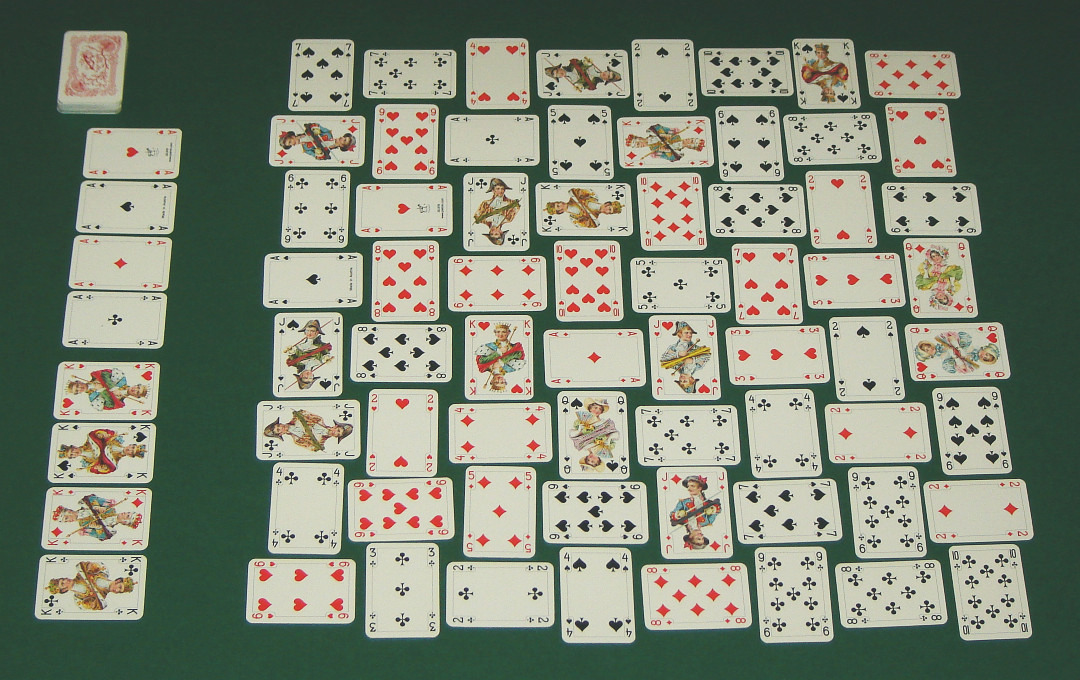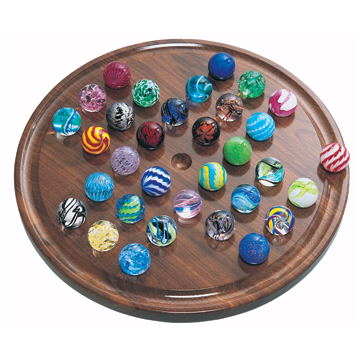|
St. Helena (card Game)
St. Helena (also known as Napoleon's Favourite or Washington's Favorite) is a patience or card solitaire game using two decks of playing cards shuffled together."Saint Helena" (p.240-241) in ''The Complete Book of Card Games'' by Peter Arnold, Hamlyn Publishing, 2010. Despite its name, it has no connection to the island with the same name, nor should it be confused with the better known Napoleon at St Helena, also called Forty Thieves in the US. Rules Explained here is the prevalent version. First, one king and one ace of each suit are removed and place in the middle of the table in two rows as shown. They are called the bases for the foundations. The kings form the upper foundations, while the aces form the lower foundations. Then, the rest of the cards are dealt clockwise into twelve piles starting with the upper left king. The table should now look like this: The object is to build the upper foundations down by suit to the aces, and the lower foundations up by suit. The top ... [...More Info...] [...Related Items...] OR: [Wikipedia] [Google] [Baidu] |
Patience (game)
Patience (Europe), card solitaire or solitaire (US/Canada), is a genre of card games whose common feature is that the aim is to arrange the cards in some systematic order or, in a few cases, to pair them off in order to discard them. Most are intended for play by a single player, but there are also "excellent games of patience for two or more players". Name 'Patience' is the earliest recorded name for this type of card game in both British and American sources. The word is French in origin, these games being "regarded as an exercise in patience." Although the name solitaire became common in North America for this type of game during the 20th century, British games scholar David Parlett notes that there are good reasons for preferring the name 'patience'. Firstly, a patience is a card game, whereas a solitaire is any one-player game, including those played with dominoes or peg and board games. Secondly, any game of patience may be played competitively by two or more players. Am ... [...More Info...] [...Related Items...] OR: [Wikipedia] [Google] [Baidu] |
Card Solitaire
Patience (Europe), card solitaire or solitaire (US/Canada), is a genre of card games whose common feature is that the aim is to arrange the cards in some systematic order or, in a few cases, to pair them off in order to discard them. Most are intended for play by a single player, but there are also "excellent games of patience for two or more players". Name 'Patience' is the earliest recorded name for this type of card game in both British and American sources. The word is French in origin, these games being "regarded as an exercise in patience." Although the name solitaire became common in North America for this type of game during the 20th century, British games scholar David Parlett notes that there are good reasons for preferring the name 'patience'. Firstly, a patience is a card game, whereas a solitaire is any one-player game, including those played with dominoes or peg and board games. Secondly, any game of patience may be played competitively by two or more players. Am ... [...More Info...] [...Related Items...] OR: [Wikipedia] [Google] [Baidu] |
Playing Card
A playing card is a piece of specially prepared card stock, heavy paper, thin cardboard, plastic-coated paper, cotton-paper blend, or thin plastic that is marked with distinguishing motifs. Often the front (face) and back of each card has a finish to make handling easier. They are most commonly used for playing card games, and are also used in magic tricks, cardistry, card throwing, and card houses; cards may also be collected. Some patterns of Tarot playing card are also used for divination, although bespoke cards for this use are more common. Playing cards are typically palm-sized for convenient handling, and usually are sold together in a set as a deck of cards or pack of cards. The most common type of playing card in the West is the French-suited, standard 52-card pack, of which the most widespread design is the English pattern, followed by the Belgian-Genoese pattern. However, many countries use other, traditional types of playing card, including those that are German ... [...More Info...] [...Related Items...] OR: [Wikipedia] [Google] [Baidu] |
Napoleon At St Helena
Napoleon at St Helena is a 2-deck patience or solitaire card game for one player. It is quite difficult to win, and luck-of-the-draw is a significant factor. The Emperor Napoleon often played patience during his final exile to the island of St Helena, and this is said to be the version he probably played. Along with its variants, it is one of the most popular two-deck patiences or solitaires. The winning chances have been estimated as 1 in 10 games,Morehead (2001), p.203. with success typically dependent on the player's ability to clear one or more columns.Galt (1999), p. 83. The game is the progenitor of a large family of similar games, mostly with variations designed to make it easier to get out. Alternative names include Le Cadran ("The Dial") and, in the US, Forty Thieves, Big Forty and Roosevelt at San Juan. History "Napoleon at St. Helena" is recorded as early as 1870 by Annie Henshaw who describes it as a "most excellent game which has the added charm of having been a f ... [...More Info...] [...Related Items...] OR: [Wikipedia] [Google] [Baidu] |
Forty Thieves (card Game)
Napoleon at St Helena is a 2-deck patience or solitaire card game for one player. It is quite difficult to win, and luck-of-the-draw is a significant factor. The Emperor Napoleon often played patience during his final exile to the island of St Helena, and this is said to be the version he probably played. Along with its variants, it is one of the most popular two-deck patiences or solitaires. The winning chances have been estimated as 1 in 10 games,Morehead (2001), p.203. with success typically dependent on the player's ability to clear one or more columns.Galt (1999), p. 83. The game is the progenitor of a large family of similar games, mostly with variations designed to make it easier to get out. Alternative names include Le Cadran ("The Dial") and, in the US, Forty Thieves, Big Forty and Roosevelt at San Juan. History "Napoleon at St. Helena" is recorded as early as 1870 by Annie Henshaw who describes it as a "most excellent game which has the added charm of having been a fa ... [...More Info...] [...Related Items...] OR: [Wikipedia] [Google] [Baidu] |
Solitaire
Solitaire is any tabletop game which one can play by oneself, usually with cards, but also with dominoes. The term "solitaire" is also used for single-player games of concentration and skill using a set layout tiles, pegs or stones. These games include peg solitaire and mahjong solitaire. The game is most often played by one person, but can incorporate others. History The origins of Card Solitaire or Patience are unclear, but the earliest records appear in the late 1700s across northern Europe and Scandinavia. The term ''Patiencespiel'' appears in ''Das neue Königliche L’Hombre-Spiel'', a German book published in 1788. Books were also reported to appear in Sweden and Russia in the early 1800s. There are additional references to Patience in French literature. In the United States, the first card solitaire book, ''Patience: A series of thirty games with cards'', was published by Ednah Cheney in 1870. The most popular card solitaire is Klondike, which was called Microsoft So ... [...More Info...] [...Related Items...] OR: [Wikipedia] [Google] [Baidu] |
Box Kite (solitaire)
Box Kite is a moderately difficult patience or card solitaire using two packs. ''Solitaire Central''. Accessed 14 October 2020. The object of the game is to move all of the cards to the Glossary_of_solitaire_terms, foundations. It is a variant of the old game of St. Helena (card game), St. Helena. Rules Box Kite has eight Glossary_of_solitaire_terms, foundations located in the middle of the tableau (patience term), tableau. The 8 foundation pile (patience term), piles are divided into two groups. There are four piles located on the top that start with a King, and build down in suit (patience term), suit. e.g. K, Q, J, 10... The other four piles start with an Ace and Build up (solitaire term), build up in suit, e.g. A♠, 2♠, 3♠, 4♠... Surrounding the foundations are twelve tablea ...[...More Info...] [...Related Items...] OR: [Wikipedia] [Google] [Baidu] |
List Of Solitaires
This is a list of patiences, which are card games that are also referred to as solitaires or as card solitaire. This list is not intended to be exhaustive, but only includes games that have met the usual Wikipedia requirements (e.g. notability). Additions should only be made if there is an existing entry on Wikipedia that they can be linked to. To avoid duplicate pages being created, alternative titles and the names of variants are listed separately (except titles that include little more than the name of the parent game). Games of the patience genre played by more than one player are marked with a plus (+) sign. A * Accordion * Aces and Kings * Aces Square * Aces Up * Acme * Addiction * Agnes * Alaska * Algerian * Alhambra * Amazons * American Toad * Apophis * Appreciate * Acquaintance * Archway * Auld Lang Syne * Australian Patience B * Babette * Backbone * Baker's Dozen * Baker's Game * Baroness * Batsford * Beetle * Beleaguered Castle * Belvedere * ... [...More Info...] [...Related Items...] OR: [Wikipedia] [Google] [Baidu] |
Glossary Of Solitaire Terms
Games of patience, or (card) solitaires as they are usually called in North America, have their own 'language' of specialised terms such as "building down", "packing", "foundations", "talon" and "tableau". Once learnt they are helpful in describing, succinctly and accurately, how the games are played. Patience games are usually for a single player, although a small number have been designed for two and, in rare cases, three or even four players. They are games of skill or chance or a combination of the two. There are three classes of patience grouped by object. The most frequent object is to arrange the cards either in ascending sequence (e.g. from Ace to King) or descending sequence. Occasionally both forms of sequence are aimed at in the same game. The card forming the starting point of the required sequence is known as the foundation card and the sequence or family is said to be 'built up' on such card. In some cases foundation cards are picked out and placed in position ... [...More Info...] [...Related Items...] OR: [Wikipedia] [Google] [Baidu] |
Double-deck Patience Card Games
A double-decker is a vehicle that has two levels for passengers or cargo, one deck above the other. Such vehicles include: * Aerial tramway * Bilevel rail car a rail passenger vehicle consisting of 2 levels * Bombardier BiLevel Coach * Bombardier MultiLevel Coach * Dome car * Double-deck aircraft * Double-deck elevator * Double-decker bus * Double-decker tram * Superliner (railcar) * Autorack (US) or car transporter (UK), a railway vehicle for transporting cars or other road vehicles * Car carrier trailer or auto carrier, a road trailer for transporting cars or other road vehicles * Two-decker is a sailing ship with 2 decks armed with cannon. A double-decker may also refer to: * Double Decker (chocolate bar) * Double-decker sandwich, such as a club sandwich or Dagwood sandwich, with two layers of meat and condiments sandwiched between three pieces of bread * A multi-level roadway such as those found in Chicago * A multi-level bridge Multilevel or multi-level may refer to: * A ... [...More Info...] [...Related Items...] OR: [Wikipedia] [Google] [Baidu] |

_Layout.jpg)



